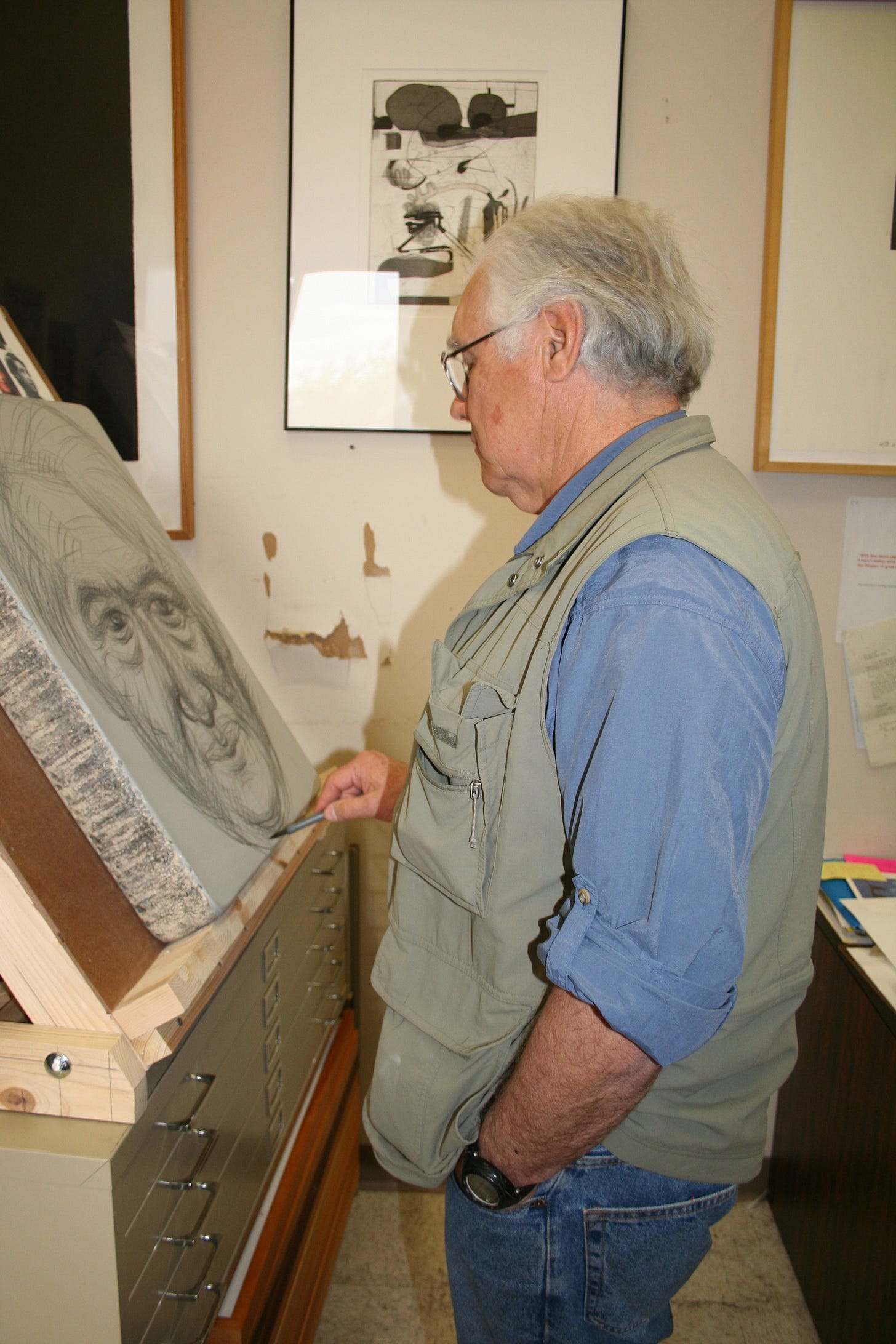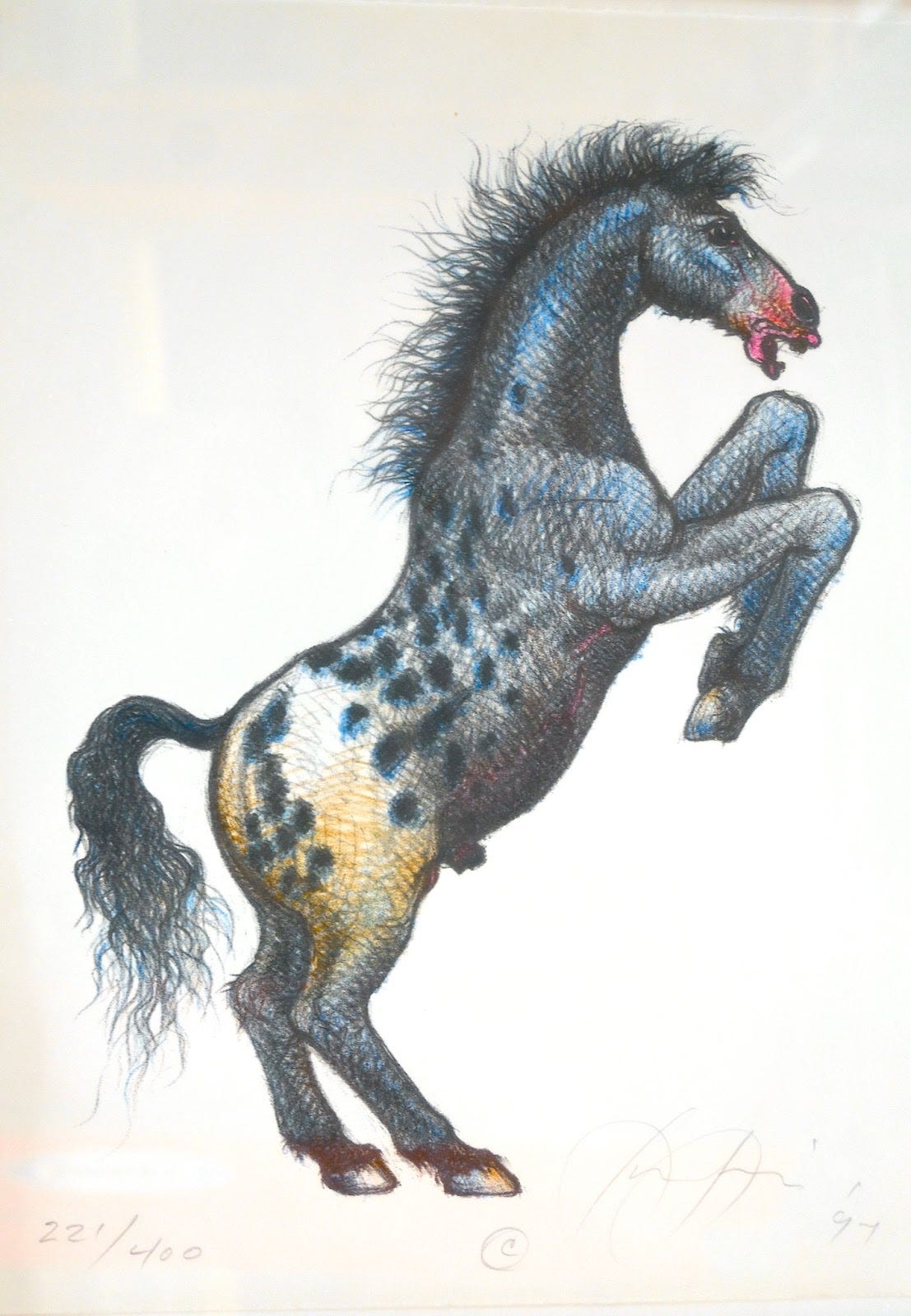Luis Jimenez represents one of the premier sculptors and painters of the new Latino art generation. Rudolfo Anaya, the highly acclaimed New Mexico Latino writer, saw in Jimenez’s passion a “deep search for an art that portrays the border region.” Anaya called Jimenez a “forerunner of a new generation of artists.” Jimenez demonstrated pride in his historical roots, as well as pride in the people of the borderlands. He was, in the words of Anaya, “bent on creating an aesthetic that reflects la frontera.”
Luis Jimenez’s “Southwest Pieta” in front of the SPARC building, Venice, Ca. Photo by Ricardo Romo.
Jimenez was a native of El Paso, born in the historic ”Secundo Barrio,” a large Mexican American community only blocks from the Rio Grande and Juarez, Mexico. He took an interest in art at an early age, and his family saved many of his childhood drawings. One early drawing of a skeleton came about after a visit to Mexico City where Jimenez experienced an artistic awakening after seeing the famous public murals of Diego Rivera and Jose C. Orozco.
In El Paso, Luis Jimenez’s father worked constructing bright large-scale signs for commercial businesses located on both sides of the border. Many of the signs included neon lights, which influenced Jimenez’s creative sense of light and sensibility. As a young boy, Luis Jr. learned to weld, cut, and mold glass. He also learned the use of spray paint at his father’s electric sign company. Jimenez left El Paso in the early 1960s to study architecture at the University of Texas in Austin. Much to his father’s disappointment, Jimenez’s interest in architecture waned. Following his graduation in 1964 from UT Austin, Jimenez decided to become an artist.
Jimenez’s love for Mexican art and three-dimensional art figures led him to Mexico City to work with Francisco Zuniga, one of Mexico’s leading sculptors and painters. While in Mexico City, Jimenez completed post-graduate studies at Cuidad Universitaria.
After two years in Mexico City, Jimenez headed to New York, one of the art capitals of the world and America’s leading city in the creation of pop art. Jimenez was among the many struggling artists living in New York City during the late 1960s. He needed a day job to pay rent and found work in the Bronx teaching Black and Puerto Rican teens who could not afford a traditional art education.
Luis Jimenez working on a lithographic drawing of Cesar Chavez. Photo by Ricardo Romo.
Jimenez’s passion for art flourished as he constructed brightly colored fiberglass and epoxy sculptures. His early works criticized “the dominant culture and the effects of racism within his subculture.” He challenged the notion that female beauty was best defined by the blond, blue-eyed woman the media had created. Jimenez argued, “the Media seemed determined to exclude anyone of color. The Mexican American or anyone who is not blond and blue-eyed is super aware of it because he [or she] does not fit this image.”
Influenced by the pop art movement, one of Jimenez’s numerous paintings includes a woman making love to a Volkswagon car. He told art critic Lucy R. Lippard that he “used popular images to take his work as close to the edge as he could.” Sex, death, nature, and Mexican and Latino culture are inextricably merged in several works.
Numerous public controversies emerged regarding Jimenez’s art, as often happens with abstract art. Various interpretations are conflicted about the meaning of his pieces. An example was one of his “Man on Fire” seven-foot-tall bronze sculptures. Jimenez acknowledged to the University of Arizona Museum of Art staff that the piece was influenced by one of Orozco’s most famous paintings, “Man of Fire.” Orozco completed the painting at the Hospicio Cabanas in Guadalajara, Jalisco.
Luis Jimenez’s “Man on Fire” sculpture in front of the McNay Art Museum entrance. San Antonio, Texas. Photo by Ricardo Romo.
Some art critics have suggested that Jimenez’s “Man on Fire” relied on a legend that Aztec Chief Caultecmoc had been tortured by the Spaniards in the midst of the conquest of Mexico, creating a man on fire. Jimenez’s comments to writer Jonathan Yorba in a Smithsonian publication, Arte Latino, suggested more complexity to the meaning. Jimenez told Yorba that his Man on Fire memorializes the disproportionately large number of Chicanos who were drafted into the military and sent to Southeast Asia.” Jimenez was influenced by “watching television in horror as Vietnamese monks set themselves on fire in protest to the war.” He told Yorba that the sculpture “on a universal level, serves as a visual symbol of courageous action in the face of oppression.”
Jimenez left New York for New Mexico in 1972 following a commission he received from the Donald B. Anderson and Roswell Museum and Art Center to complete two large sculptures titled “Progress I” and “Progress II.” During the seventies, he received several awards from the National Endowment for the Arts [NEA]. An NEA award with the City of Albuquerque to create “Southwest Pieta” was surrounded by controversy as the community chose not to place the sculpture in Old Town, a historic part of the city. The sculpture was moved to the barrio of Martineztown.
I met Luis Jimenez in 1985 when I accepted an assignment from Humanities Texas to write about his exhibition at Austin’s Laguna Gloria Museum. In my interview with him, Jimenez was pleasant, at times blunt, and somewhat irreverent about his family’s strict Protestant upbringing. With an NEA commission with the City of Houston, Jimenez produced “Vaquero,” a controversial sculpture intended to place the Mexican cowboy at the center of American art of the West. The Mexican vaquero had a large six gun pointed in the air. The decision to place the sculpture in the center of a Hispanic park in Houston sparked resistance because Latinos did not wish to romanticize guns and violence.
For more than 20 years, the Smithsonian American Art Museum in Washington D.C. exhibited Jimenez’s “Vaquero” sculpture at the museum’s front entrance. At the time, the sculpture represented the rare inclusion of a Latino artist. Humanities Texas used this same Vaquero image on the cover of the organization’s journal, another first for a Texas Latino artist.
Mustang drawing used as a small-scale model for the Denver Airport sculpture. From the collection of Harriett and Ricardo Romo.
Jimenez’s massive sculpture of a mustang bronco near the main entrance of the Denver Airport is perhaps his most viewed and most famous work of art. This 50-foot sculpture is a tragic memory for his family and friends. Jimenez died in 2006 at his studio in Hondo, New Mexico when the nearly completed bronco sculpture fell and crushed him. However, his work lives on as he is prominently exhibited in museums throughout the United States.







As a young printmaker new to San Antonio in 2002, I had the distinct privilege of working closely with Luis on a large scale lithograph. He immediately impressed me with his contemplative, serious approach both to the medium and his subject matter. He graciously instilled me with the confidence I needed to work on the technical aspects of the project. Four years later, I had took the opportunity to work on another lithograph with him (the pictured portrait of Cesar Chavez). Luis was very kind again, telling me he was excited to learn I would be the printer working on the project. He planned a four color lithograph, but soon after finishing the key image, he died. We were able to print the edition as a single color lithograph with permission from his estate. I will be forever thankful for my brief association with him.
Thank you Ricardo. This brings back so many wonderful memories. Luis was such a treasure and one of my heros. I first ran into his work in New York. I was immediately bowled over and loved it. I was so honored to meet him and call him a friend! I miss him very much.